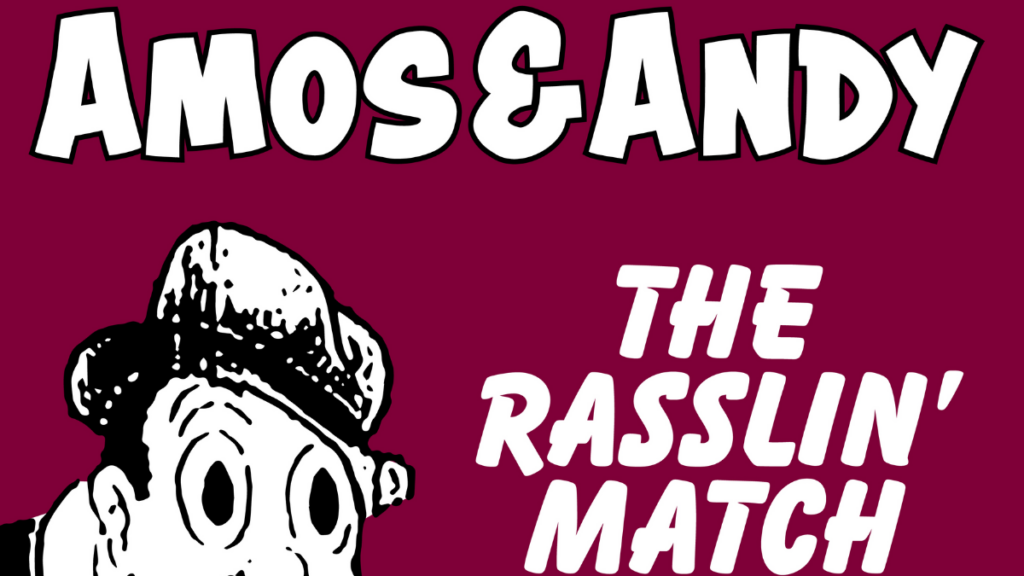In reviewing this 10-minute long cartoon, The Slam Wrestling Movie Database provides only a glimpse into the fascinating history of the Amos and Andy characters. For those unfamiliar with them, the cartoon will be seen as a simple story about a non-wrestler who gets a shot at the wrestling champ — a tale that has certainly been told countless other times. The story behind Amos and Andy, though, and of Corell and Gosden, is where the real fascination lies: the story of characters that were wildly successful and unendingly controversial — all at the same time.
Corell and Gosden created their on-air personas for Chicago radio, becoming quickly successful as they brought their simple-minded characters, at first named Sam and Henry, to an audience all-too-willing to accept them at face-value for what they were: caricatures of black citizens identified by Corell and Gosden’s purposeful use of black slang.
While hardly the only radio show to feature a systemic insensitivity to the power it held over its audience in terms of perpetuating stereotypes (another popular show of the time, The Goldbergs, for example, played up generalities of its Jewish characters), Amos ‘n’ Andy stood apart for two reasons: its immense national popularity before the second World War and the backlash against the characters following the end of the war.
Amos ‘n’ Andy was topping the radio charts in the early 1930s, which, in a sense, led to its position as the most easily targeted source of stereotypical programming once the social landscape regarding racial and religious tolerance changed after World War II. Americans were seeing film footage from the fights overseas where all of its citizens were fighting side-by-side and, coupled with the knowledge that they were fighting against genocidal forces, a new fight for equality was brewing at home. Only once the characters were brought to life in a televised sitcom, premiering in 1951, did a hostile response from the public really start pouring in.
The National Association for the Advancement of Coloured People (NAACP) in particular led a charge against the show by highlighting several issues they had with the show, namely that all black characters, be they men, women, doctors, lawyers, or any other position, is portrayed as “inferior, lazy, dumb and dishonest.” The NAACP protested that “millions of white Americans see this Amos ‘n’ Andy picture of Negroes and think the entire race is the same.” What is perhaps an ironic point lost in the history of its transition from radio television is that Corell and Gosden were white actors delivering black-stylized dialogue, even appearing in public wearing black-face, while the television show featured black actors — which created a strong support for the show from many black communities who saw that part of the production as indeed the advancement of colored people.
A 1930 newspaper ad for an Amos ‘n’ Andy film.
The Rasslin’ Match entered the public well before this point, of course, but it was a key transitional element for the eventual production of an Amos ‘n’ Andy television show. Featuring the voices of Corell and Gosden, thereby creating a continuity from the radio show, the plot is, as mentioned before, simple enough. Amos, along with the unscrupulous character Kingfish, cooks up a scheme for Andy to fight the wrestling champ and make a boatload of money. Andy goes through training exercises that don’t seem to do him any good (think Rocky III by way of Nacho Libre), and loses his nerve when he sees what awaits him in the ring. Amos forces him in though and, utilizing a black wrestler’s stereotype that has through the ages, Andy’s impenetrable skull gives a chance at victory.
The cartoon fails to provide anything that makes it a “must-see” — its storytelling, characters, and animation are all sub-par even by contemporary standards (Disney released Snow White and the Seven Dwarfs only three years later). Once again, though, its role in bridging the gap between the radio and television show, along with another cartoon and a feature-length film, is perhaps its strongest legacy.
Amos ‘n Andy: ‘Rassling Match (1934)
| Tag Line: | Kingfish talks Andy into getting into professional wrestling, and sets him up in a match with a real bruiser. |
| Directed By: | Vernon Stallings |
| Written By: | Charles J. Corell, Freeman F. Gosden |
| Cast: | Charles J. Corell, Freeman F. Gosden |
| Runtime: | 11 minutes. |

